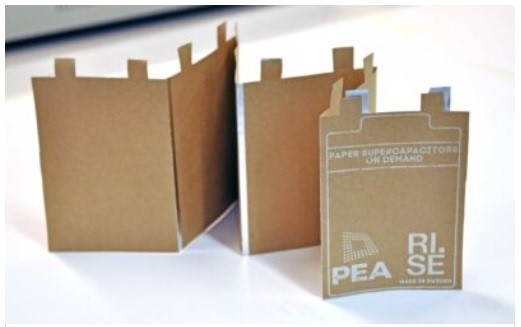

Researchers from Sweden’s Digital Cellulose Center have come up with an enhanced version of their previously developed paper supercapacitor yielding 10F through a demonstration drive. In the former version, one would come across aluminium-coated plastic substrates, but in the latest one, they have incorporated an aluminium-coated paper variation, creating a sustainable paper supercapacitor.

The current materials that comprise the capacitor are cellulose pulp derived from softwood and a water-based ink made from the conductive polymer PEDOT: PSS, along with some compatible substances like activated carbon.
The Center had screen-printed this on an aluminium-coated plastic substrate just a while back. Still, in this upgraded version, the Researchers have swapped the plastic for paper, creating an aluminium-coated paper supercapacitor.
Aluminium helps in storing energy and also is very beneficial in eradicating oxidisation and moisture sedimentation. The carbon layers on the metal prevent corrosion inside the cell, ultimately extending the lifetime of the capacitors.
The project leader at Sweden’s Digital Cellulose Center, Jesper Edberg, commented: “The capacitance of the paper supercapacitor is approximately equivalent to commercial supercapacitors when normalised against volume. One of the advantages of paper devices is how they are manufactured, which we believe can lead to faster production. They are also thin, foldable and bendable, and can be integrated into new environments where the cylindrical-shaped, metal commercial supercapacitors do not fit.”
Robert Brooke, a researcher at RISE (Research Institutes of Sweden), with which the Digital Cellulose Center worked on this project, illustrated: “These energy storage devices could, for instance, be built into the walls of buildings to store energy locally from solar cells on the roof while at the same time functioning as insulation for the building.”
The demonstration samples are specially designed to be promptly connected in series for greater voltage and also can be separated into four tinier supercapacitors.
“If you have a small electronic device that needs minimal power, then you can use an individual sheet of the energy storage device. If you want to power something that needs more, then you can connect devices, or sheets, to increase the voltage or the capacitance,” Robert Brooke very skilfully illustrated.
The device displayed a capacity up to 10F “while expanding the area with the large parallel device increased the capacitance to a record 127.8F, which is 332.8mF/cm2,” the Center claims.
The supercapacitors have been handmade, temporarily using a multi-step process that will be required at the time of actual mass production.
To showcase the capacity of the supercapacitors, the researchers from Digital Cellulose Center also combined their flagship product with an all-printed electrochromic display gifting the city of Norrkoping; an incredible art installation called the ‘Norrkoping Starry Night’, inspired by Gogh.
Responses








